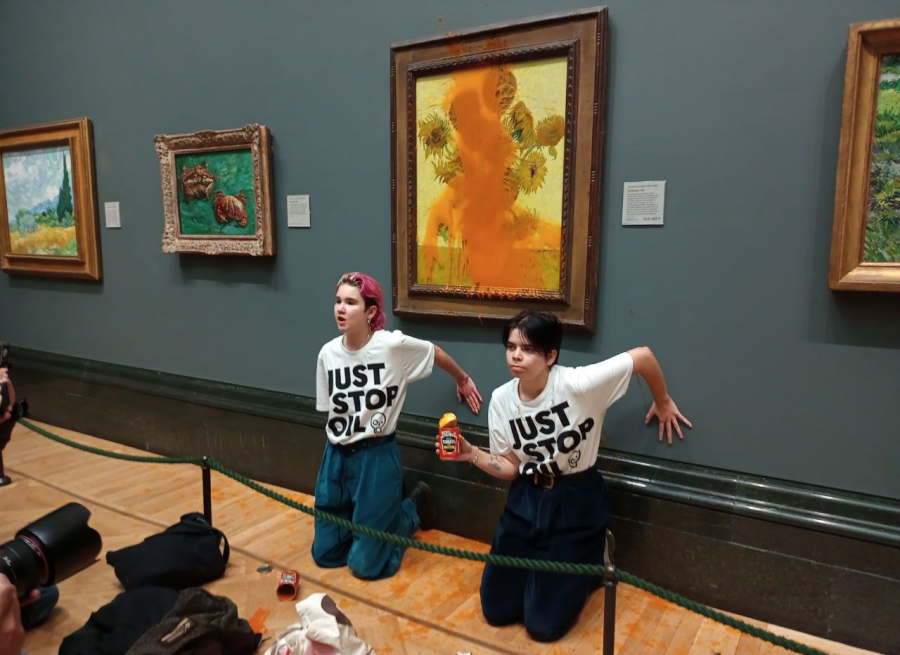Utilized and Targeted: Art’s Complicated Role in Climate Activism
What is worth more: art or life? This profound question is what climate activists asked onlookers when their group, Just Stop Oil, threw tomato soup on Van Gogh’s “Sunflowers” in October 2022.
Many called this act of protest embarrassing. It was dubbed performative activism (a term I believe we use a bit too freely). Online rhetoric and media coverage reduced these protests to acts of vandalism. Young activists inspired other activists, and similar protests have occurred involving other works of art. Just last week, climate activists in D.C. smeared paint on the display that encases Edgar Degas’s sculpture “Little Dancer Aged Fourteen.”
The criticism these groups received feels unfair. I myself love Van Gogh, but “Sunflowers” was behind glass and it’s doing fine. It was disappointing to see people in my own circles — even those who are especially environmentally conscious — feel embarrassed by a movement they normally resonate with. I recall the somewhat ignorant “What did the painting do to the climate?” jokes my peers made, but these sorts of remarks overlook the point.
I want to be clear: I don’t think art is the enemy. In fact, I think the environmental movement needs more art. Creative expression can be advantageous in spreading climate-related messages. The inclusion of art in climate activism draws in a larger audience, making environmentalism unignorable. Not to mention, art has long been inspired by nature. Art and environmentalism can beautifully go hand-in-hand. However, I also understand the desire to target art, and I’d defend the Just Stop Oil activists.
I think their peculiar protest model is an incredible one to follow. Of course, it may have a disappointing consequence for the environmental movement: people may be put off the movement rather than drawn to it, but that consequence seems to arise from a misguided attitude.
I think we can all recognize that protests like these are for media attention, but we need to reframe seeking media attention in a positive light — as something helpful and incredibly necessary rather than the shallow goal of an outlandish stunt. “Attention seeking” is needed for a cause — the climate crisis — that’s so critical it can’t afford to be nitpicked or have its movement’s methods criticized.
There’s a lot to say about why forms of protest like these are a critical tool for the environmental movement.
For climate protesting in particular (because it’s such an ongoing cause), the media gets easily accustomed to certain displays of activism — so much so that things like marches and strikes become old news and lose their efficiency while the climate crisis prevails. Also of particular importance for environmental issues is the nature of an “unexpected” protest. An unexpected confrontation with the climate crisis helps to call attention to the fact that the crisis will only impact our everyday lives more and more, so it’s something we should care about every day. Instead of just making people care about the climate when a major event occurs (like marching after an oil spill would do, for example), unexpected protests bring attention to the environment during seemingly optimistic times and in seemingly comfortable spaces.
An important point of targeting art is creating an uncomfortable environment in one of the most comfortable places of culture: the leisurely enjoyment of art. A museum — as a refined place to display things — can often create a space that feels separate from environmental issues. When protestors blur that separation, they force museum attendees to think about the environment in a space they weren’t expecting to. On a larger scale, it brings the whole environmental movement into more spaces.
I’d dare to say that it’s also important to consider how art is historically a mode of expression. Art creates a space of communication, and in general, we need more communication about the Earth. To be put off from the environmental movement by unusual forms of protests is to tell climate protestors to stay in their place and only speak out when we think it’s needed. Environmental discourse is always needed.
This all isn’t to say that climate activists should be free from criticism. It’s important for any movement to check itself as it grows. But this sort of criticism—calling people concerned about the planet embarrassing and “attention-seeking”—gets us nowhere and undermines an important form of protest.

Rylee Hatch is a sophomore from East Fishkill, NY concentrating in English and environmental studies. She has previously served as a staff writer for the...










